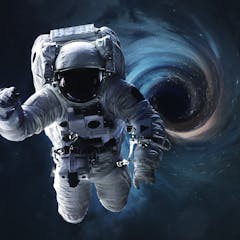
Articles on Black holes
Displaying 41 - 60 of 136 articles

The black hole is part of a binary star system within our Milky Way galaxy. It orbits a colossal supergiant companion star.

A small add-on to existing gravitational wave detectors could reveal what happens to matter as it becomes a black hole, a process like the big bang in reverse.

Some of the baby radio galaxies found may not be ‘babies’ at all. Rather, they may be ‘angsty teens’, rapidly growing into adults much faster than researchers had anticipated.

Calculations show that wormholes should create a spectacular display of gamma rays that we could try to observe.

Not all planets orbit stars. Rogues float through the galaxy in darkness and are almost impossible to see.

The scariest beast in the universe has an insatiable appetite and shreds its victims.

Roger Penrose helped resurrect Einstein’s general theory of relativity, and Reinhard Genzel and Andrea Ghez showed there was a black hole in the middle of our galaxy.

New discovery settles a wager between astrophysicists: black holes can merge repeatedly.

Researchers have made some of the most accurate clocks imaginable in recent years, but the trick is harnessing those clocks to electronics. Using lasers to tune microwaves bridges the gap.

Like a cosmic butterfly in the sky, radio galaxy PKS 2014-55 was observed by CSIRO researchers with the Australian SKA Pathfinder telescope.

Astronomers using a new technique to hunt black holes found one 70 times as heavy as the Sun

If you got too close to a black hole, it would suck you in and you’d never be able to escape, even if you were travelling at the speed of light.
This point of no return is called the event horizon.

A spinning black hole is pumping vast amounts of energy back into the surrounding universe, but something is causing the jets that transport that energy to wobble very rapidly.

Astronomers say they have “seen what we thought was unseeable” in releasing the first image of a supermassive black hole. So how did we get to this historic observation?

Scientists turned Earth into one giant telescope to capture the uncapturable.

Feel like visiting another star system or dimension? You can do this by traveling through a spacetime portal of a black hole. But you better choose carefully. All black holes are not created equal.

The crucial phase of our discovery of black holes took place in a suitably dark period of human history – World War II.

A black hole is an object with such a strong gravitational pull that nothing, not even light, can escape from it.

More ripples in space-time have been detected from merging pairs of black holes, one of which was the most massive and distant gravitational-wave source ever observed.

Astronomers have suspected them for ages –now a team as finally spotted a ‘fountain’ in a galaxy far, far away.
